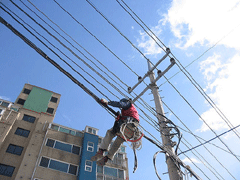Electric Green Jobs
Air Date: Week of February 6, 2009

An electrician at work.
President Obama's stimulus plan could mean thousands of jobs for qualified electricians and money for training apprentices. Michael Callanan, executive director of the National Joint Apprenticeship Training Committee, tells host Bruce Gellerman that investing in renewable energy and energy efficiency is a win for the environment and for blue collar workers.
Transcript
GELLERMAN: The stimulus package is designed to shock the economy back to life but that won’t happen without a big jolt of electricity - there are billions in the plan for windmills and solar panels, electric cars, smart meters and a revamped power grid.
All good news for Michael Callanan and the tens of thousands of students he hopes to train to meet the expected shortage of electrical workers. Michael Callanan is the Executive Director of the National Joint Apprenticeship Training Committee. He says the billions to re-power America will provide good prospects for green electricians.
CALLANAN: One of the greatest provisions of the American Recovery and Reinvestment Act and the stimulus package is the allocation of probably about $ 11 billion dollars in grid investment, and one of the key components of that is going to be the transmission line and the development of the transmission line. The stimulus package calls for over 3,000 miles of new transmission line development. To put that in context, since 2000, there’s only been 688 miles of interstate transmission lines developed. So this is going to be a huge challenge for us to be able to get the renewable energy back to where we can use it.

Michael Callanan.
CALLANAN: We have been fundamentally teaching the skills required to do green jobs for years – a number of years. So our focus will be on specifically looking at ways to increase the productivity of these new technologies. For example, wind turbines. The basic skills required to work in wind turbines we’ve been teaching for years, but the nuances of working with these new generations of wind turbines and safety requirements, fall protection, we’ll be focusing and utilizing a boot camp approach. So for those existing workers that have been in the trade for a number of years, we’ll send them to upgrade training and then they’ll work specifically on things like the skills that they need for the particular technology that they’ll be working on. And then we’ll be working on the building efficiencies. I think that should be our primary concern. Forty percent of the total energy consumed in the United States is consumed by the buildings themselves. And so it makes sense to me that we should be focusing on things like building automation, lighting controls, energy efficiency in our ballast, our lamps, those types of projects.
GELLERMAN: So is it conceivable that there’ll be all this money to build these 3,000 miles of, you know, high power lines and the wind mills and the solar panels – all the rest – and we won’t have the electricians to build the infrastructure around it?
CALLANAN: You know, as a colleague of mine is fond of saying, there may be – there will never be a shortage of bodies. What there may be a shortage of is skilled workers. This is just, you know, a demographic issue. There’s just less 20-25, 25-30 year olds in the workplace today. On top of that, I think that we’ve suffered in the construction industry from this mantra over the last ten or fifteen years that your sons and daughters aren’t successful unless they go to college. We’re taking people from flipping burgers one day and the next day we’ve got ‘em into a full-blown four-year career in an apprenticeship system.
The neat thing about apprenticeship systems is if they combine related instruction, classroom training where they’ll work on the theoretical aspects of the trade and on the job training. And I think this is a component that’s been missed. I mean this is a model that dates to the middle ages and it involves earning while you learn potential. For most of these apprentices there’s no tuition to join, there’s no school fees other than buying their books and their tools, and they’re working in the trade, they have a job, and they continue to learn their trade through related instruction in the evenings and weekends and in some cases regular day schools. Graduates of these mid level type programs in our apprenticeship programs on average earn between 45 and 60 thousand dollars a year.
GELLERMAN: So blue collar green jobs.
CALLANAN: Absolutely.
GELLERMAN: Well electrification was the major economic stimulus in the 1930s. And it seems that we’re going to the same well right now. It’s all about electricity.

An electrician on the job.
GELLERMAN: Well thank you very much Mr. Callanan. I really appreciate it.
CALLANAN: Thanks for the opportunity to be on your show.
GELLERMAN: Michael Callanan is executive director of the National Joint Apprenticeship Training Committee.
[MUSIC: Donald Fagan “Green Flower Street” from The Nightfly (Warner Bros 1982)]
GELLERMAN: Just ahead – he’d be 200 years old this month – but we’re still learning new things about the evolution of Charles Darwin’s revolutionary idea. Keep listening to Living on Earth!
Links
Living on Earth wants to hear from you!
Living on Earth
62 Calef Highway, Suite 212
Lee, NH 03861
Telephone: 617-287-4121
E-mail: comments@loe.org
Newsletter [Click here]
Donate to Living on Earth!
Living on Earth is an independent media program and relies entirely on contributions from listeners and institutions supporting public service. Please donate now to preserve an independent environmental voice.
NewsletterLiving on Earth offers a weekly delivery of the show's rundown to your mailbox. Sign up for our newsletter today!
 Sailors For The Sea: Be the change you want to sea.
Sailors For The Sea: Be the change you want to sea.
 The Grantham Foundation for the Protection of the Environment: Committed to protecting and improving the health of the global environment.
The Grantham Foundation for the Protection of the Environment: Committed to protecting and improving the health of the global environment.
 Contribute to Living on Earth and receive, as our gift to you, an archival print of one of Mark Seth Lender's extraordinary wildlife photographs. Follow the link to see Mark's current collection of photographs.
Contribute to Living on Earth and receive, as our gift to you, an archival print of one of Mark Seth Lender's extraordinary wildlife photographs. Follow the link to see Mark's current collection of photographs.
 Buy a signed copy of Mark Seth Lender's book Smeagull the Seagull & support Living on Earth
Buy a signed copy of Mark Seth Lender's book Smeagull the Seagull & support Living on Earth

